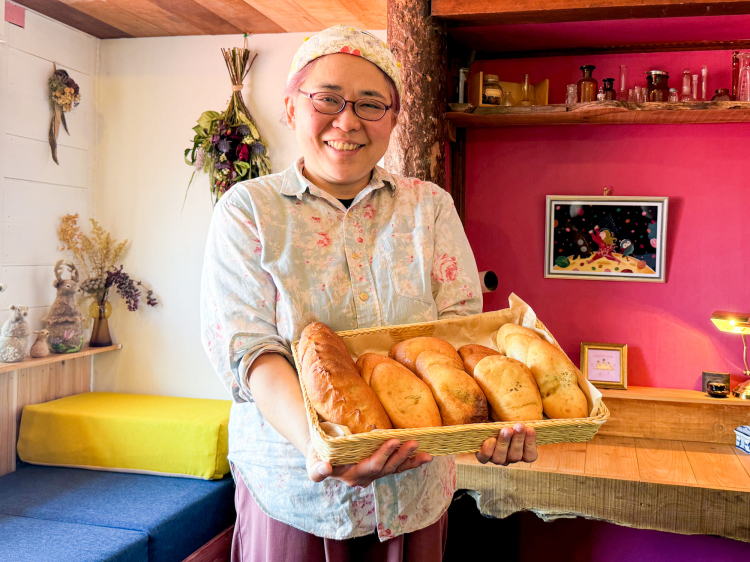ReservationSearch and reserve rooms
Click here to confirm, change or cancel your reservation
Shinkansen accommodation plan
提携法人専用予約
2024.10.31
Enjoy Eastern European baked piroshki and borsch in Hakodate at Marutama Koya


Located near the base of the Mount Hakodate Ropeway, this building has a white exterior that exudes a sense of age. The sign reads "Marutamagoya." As you open the door, saying hello to the animal dolls at the entrance, you'll be greeted by the bright and cheerful smile of the owner, Kitami Nobuko, a fragrant aroma, and a colorful and atmospheric interior and books.

A fateful encounter with baked piroshki

Kitami-san moved to Hokkaido to attend university, and after studying abroad and getting married, she moved to Hakodate. At that time, she was completely captivated by the deliciousness of the baked piroshki served at a famous Russian restaurant that used to be in Hakodate. She decided, "I'll open a piroshki restaurant too!"
By the way, when we think of piroshki, they are deep-fried, with the fillings of a steamed bun and glass noodles added, giving them a somewhat oriental feel. However, Kitami-san told us, "Most of the authentic piroshki eaten in Eastern Europe, such as Russia and Ukraine, are baked, and the fillings are often simple."
"I was originally interested in Russia and other Eastern European countries," says Kitami. While researching various types of piroshki, he focused on piroshki from a certain shop in Ukraine. Thinking that he needed to learn more about Ukraine, Kitami became the head of the Hokkaido branch of the Japan-Ukraine Cultural Exchange Association. Armed with the English he had acquired while studying abroad as a student, he continued to research piroshki in parallel with various cultural activities.
A unique taste created by combining baked piroshki with ingredients from Hokkaido

And so Kitami's baked piroshki is finally complete. "A Russian customer who came to our restaurant once praised us, saying, 'This is even more delicious than the piroshki in my hometown!'" says Kitami.

A display case with many piroshkis lined up. Take note of the catchy explanations.
Their commitment extends beyond just the grilling process, to the dough and ingredients as well. For example, their signature product, "Ezo x Ezo," is made with plenty of odorless venison processed in Hakodate and Siberian maitake mushrooms, resulting in a delicious product. The apples used in the dessert-like "Salted Butter Apple" are from the neighboring town of Nanae. The soybean paste used in the dough is also sourced from tofu shops in Hakodate and Nanae, so they are committed to producing products that are locally produced and consumed.
A special borsch made with beets, an "edible IV drip"

When talking about Russia, you can't leave out borsch. Kitami-san says, "Borsch is thought of as a Russian dish, but it actually has its roots in Ukraine." Borsch is a soup made by carefully simmering vegetables and meat.
The defining feature of the soup is undoubtedly beets. We don't often see them in supermarkets, but Marutama Koya has contracts with farmers in Hokkaido to produce them, which allows them to purchase them regularly. "Rather than just cutting and stewing beets, the sweetness is enhanced when they are slowly grilled, so we value this extra step."
Looking at Kitami's borsch soup, you'll notice that it has a beautiful, clear pink color. "When you eat borsch at a Western restaurant, you can taste the tomato flavor, but the real thing has a much richer flavor," says Kitami. "Our borsch only has a small amount of tomato added to add flavor, and the base of the flavor is made from beets." The only seasoning used in his homemade borsch is salt. When you take a sip, the sweetness of the beet and the gentle flavor of the other vegetables permeate your entire body and envelop your heart.
Furthermore, the ingredients of authentic borsch change depending on the season, so they serve "green borsch" in the spring, "pink borsch" made with beets and cucumbers in the summer, and "white borsch" made with potatoes in the winter. The fact that you can enjoy the menu while feeling the seasons is possible because Kitami-san traveled to Ukraine to learn more.
A shop and its products that are as dear to me as my own children. I can feel the owner's passion with every part of my body.
"Sometimes I try them myself and think to myself, 'Our baked piroshki and borsch are delicious,'" says Kitami. All the dishes served at the restaurant are miraculous dishes that were born from Kitami's insatiable curiosity and vitality to travel to different places, his feelings for Eastern Europe, and his shocking encounter with baked piroshki in Hakodate.

The eat-in space, which was newly expanded in April 2024, is like a power spot, decorated with Marutamagoya's original Ukrainian-style paint. "The menu and this space are all my favorites, and I've put a lot of effort into creating them," said Kitami-san, gazing lovingly at the restaurant's proud dishes and eat-in space. Enjoying baked piroshki and borsch in this new space, where the refreshing breeze of Hakodate blows through, is sure to soothe your travel fatigue and fill your heart.
まるたま小屋
電話:0138-76-3749
住所:北海道函館市元町2-3
アクセス:函館市電「十字街」徒歩10分/函館ロープウェイ山麓 徒歩2分
HP:https://marutamasquare.wixsite.com/marutama
SNS:https://www.instagram.com/marutamagoya/
*営業時間や定休日についての詳細は、上記のリンク先にてご確認ください




